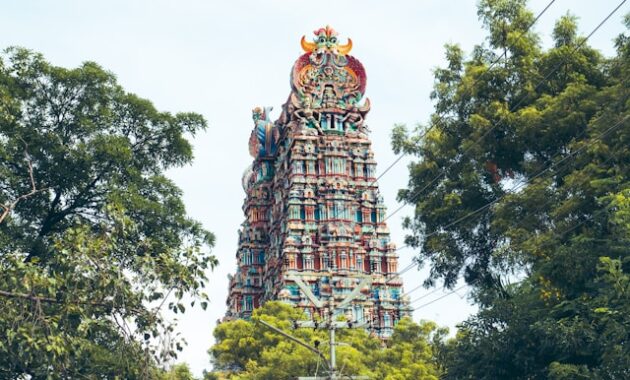
Meenakshi Amman Temple, located in the heart of Madurai, Tamil Nadu, is not merely a religious site—it is a majestic epitome of Dravidian architecture, spirituality, and centuries-old tradition. Revered by millions, this architectural masterpiece stands as a vibrant symbol of Tamil culture and Hindu faith. A spiritual and cultural beacon, the temple attracts pilgrims, historians, and travelers from across the globe.
Historical Significance of Meenakshi Amman Temple

The origins of the Meenakshi Temple date back over 2,000 years, although the current structure was mostly built during the Nayak dynasty in the 16th century, particularly under the patronage of King Tirumalai Nayak. However, the temple’s historical roots run much deeper, with literary references found in ancient Sangam literature, indicating its significance during the early centuries CE.
The temple is dedicated to Goddess Meenakshi, an incarnation of Parvati, and her consort Lord Sundareswarar, a form of Shiva. The dual worship of male and female deities sets this temple apart in the Shaivite tradition, celebrating divine union in all its glory.
Architectural Brilliance and Dravidian Aesthetics
Towering Gopurams: Gateways to the Divine
One of the most striking features of the Meenakshi Temple is its 14 massive gopurams (gateway towers). These intricately carved towers, some soaring up to 170 feet, are adorned with thousands of colorful statues depicting gods, goddesses, demons, and mythological creatures. The South Tower, the tallest, stands as an enduring symbol of Tamil temple architecture.
Each gopuram is a visual encyclopedia of Hindu mythology, meticulously sculpted by artisans with deep spiritual devotion and artistic prowess. These towers serve not only as architectural landmarks but also as spiritual beacons guiding devotees toward enlightenment.
Aayiram Kaal Mandapam: The Thousand Pillar Hall
The Aayiram Kaal Mandapam, or Hall of a Thousand Pillars, is a testament to the engineering ingenuity of the Nayak rulers. Though technically comprising 985 intricately carved pillars, each one is a unique artistic statement. Built from granite, these pillars feature elaborate depictions of deities, celestial beings, and mythical animals.
This hall also houses the Meenakshi Nayakkar Mandapam Museum, which showcases sculptures, artifacts, and historical documentation of the temple’s development and religious significance.
Sacred Tanks and Corridors
The Golden Lotus Tank (Potramarai Kulam) within the temple complex is of profound importance. Legend holds that this tank has the power to judge the worthiness of literary works, a claim rooted in the temple’s connection to ancient Tamil scholarship. Surrounded by corridors, this tank is a place for devotees to purify themselves before entering the inner sanctum.
The corridors that circle the sanctum are vast and ornately sculpted, reflecting the Dravidian style with precision—thick stone columns, rich iconography, and sacred inscriptions narrating divine tales.
Spiritual and Religious Importance
The Meenakshi Amman Temple is not just an architectural wonder but a living, breathing place of worship, hosting daily rituals, seasonal festivals, and elaborate ceremonies throughout the year.
Meenakshi Thirukalyanam: The Celestial Wedding Festival
One of the most celebrated events at the temple is the Meenakshi Thirukalyanam, the divine wedding of Meenakshi and Sundareswarar. Held in the Tamil month of Chithirai (April-May), this grand celebration draws millions of pilgrims and is a cultural spectacle featuring processions, music, dance, and rituals lasting ten days.
Daily Pujas and Ceremonial Offerings
The temple hosts six daily rituals, beginning at dawn and ending at night. Each ritual includes abhishekam (holy bath), alangaram (decoration), naivedyam (food offering), and deepa aradanai (waving of lamps). The procession of the idols inside the complex every night is a sight of divine grace and community devotion.
Mythology and Legends Surrounding the Temple
According to legend, Meenakshi was born with three breasts, and it was foretold that the third would disappear upon meeting her future husband. This came true when she met Lord Shiva in battle—only for the two to fall in love, leading to their sacred union.
The temple is thus a symbol of cosmic balance, celebrating the union of male and female energies, devotion, valor, and love. Such legends are not merely stories—they are spiritual lessons embodied in stone and ritual.
Cultural and Artistic Influence
The influence of Meenakshi Temple extends far beyond Madurai. It has been a cradle of classical Tamil music, Bharatanatyam dance, sculpture, and literature. The temple premises regularly host cultural performances, particularly during festivals, turning its courtyards into open-air stages where tradition comes alive.
Visitor Experience and Practical Information
Best Time to Visit
While the temple is open throughout the year, the best time to experience its full grandeur is during Chithirai Festival (April-May). Other favorable months include December to February, when the weather is more pleasant.
Temple Timings and Entry Guidelines
- Opening Hours: 5:00 AM to 12:30 PM and 4:00 PM to 9:30 PM
- Dress Code: Modest attire is recommended. Traditional Indian wear is ideal.
- Photography: Not permitted inside the sanctum, though allowed in the outer areas.
Nearby Attractions
- Thirumalai Nayakkar Palace – A fine example of Indo-Saracenic architecture.
- Gandhi Memorial Museum – Preserving the legacy of Mahatma Gandhi.
- Alagar Kovil and Pazhamudircholai – Hill temples on the outskirts of Madurai, rich in mythology.
Preservation and Global Recognition
The temple is under the care of the Hindu Religious and Charitable Endowments Department of the Tamil Nadu government. Conservation efforts are ongoing to preserve its structural and cultural integrity. Recognized as a nominee for UNESCO World Heritage Site, the temple’s global fame continues to grow, ensuring its stories and sanctity endure through generations.
Conclusion
The Meenakshi Amman Temple is more than an architectural gem—it is a spiritual epicenter, a cultural hub, and a living testament to the grandeur of Tamil heritage. Every stone, sculpture, and ceremony in this temple breathes history, devotion, and artistic brilliance. For anyone seeking to experience the soul of South India, this divine marvel in Madurai is an unmissable pilgrimage.